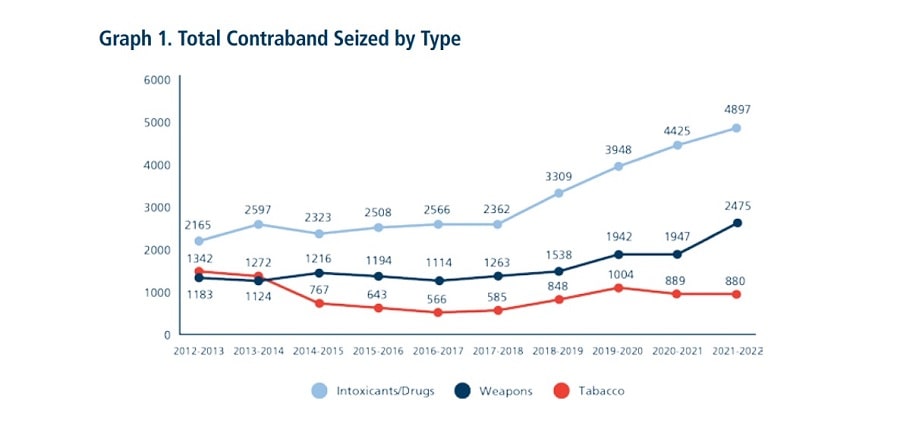Drug Smuggling In Canadian Prisons: A Major Problem Without A Clear Solution
- TDS News
- Breaking News
- February 9, 2023

Drugs have become a major problem in Canadian prisons, with a significant amount of illegal substances being smuggled into these facilities on a regular basis. Despite efforts by both the provincial and federal governments, the issue remains rampant and continues to cause harm to both inmates and staff.
The availability of drugs in prisons has serious consequences, including increased violence, decreased rehabilitation efforts, and the spread of communicable diseases. Furthermore, drugs are often used to fuel addiction and criminal behaviour, making it more difficult for incarcerated people to reintegrate into society once released.
Despite the protection measures in place by the Correctional Service of Canada, the ease with which drugs can be smuggled into Canadian prisons is due to a number of factors. One of the most significant issues is the lack of security benchmarks in place to prevent contraband from entering the facilities. This is particularly true in overcrowded prisons where staff pose challenges with monitoring the movements of inmates and visitors effectively.
Then there are the speculations of breach of trust, which is not uncommon in correctional facilities. No one likes to be accused of breaking the law, but there have been many confirmed cases of a violation of trust involving employees within correctional facilities. Some guards and other personnel have been found to be involved in the smuggling of drugs into prisons, either for personal profit or due to pressure from inmates. This not only undermines the authority of the staff but also creates an environment where drugs are readily available and can be easily distributed.
We outlined the logical ways experts believe drugs get smuggled into Canadian prisons. In all instances, we sincerely hope we are wrong because it means someone in a position of trust is a stain on the system and putting a negative spotlight on their colleagues who are upholding the law.
- Prisoners are tunnelling out of their cells at night to secure drugs Shawshank Redemption style and return before the headcount.
- Drugs are being smuggled in by correctional officers
- Drugs are being smuggled in by police officers
- Drugs are being smuggled in by correctional workers
- Drugs are being smuggled in by family/visitors/lawyers
- Drugs are being smuggled in by other inmates
- Drugs are being smuggled in by mail
- Drugs being sent over prison out walls
- Drugs are manufactured in prison
“The Correctional Service of Canada (CSC) uses a number of tools to prevent drugs from entering its institutions. These tools include ion scanners and drug-detector dogs to search buildings, personal property, inmates and visitors.” Correctional Service of Canada
Many facilities, such as the Edmonton Remand Center, have installed a body scanner that can detect if drugs are being smuggled into their facility. However, drugs are still making it past the scanner to the inmates.
The provincial and federal governments have attempted to address the problem of drug smuggling in Canadian prisons by increasing funding for security measures and increasing penalties for those who are caught. However, these efforts have been largely ineffective as the problem continues to persist.
One potential solution to the problem is to focus more on rehabilitation and education programs for inmates. This could help to reduce the demand for drugs and provide a more positive and supportive environment for those who are incarcerated. Furthermore, providing support and resources for those who are struggling with addiction could help to reduce the likelihood that they will turn to drugs as a means of coping with their situation.
CSC’s Drug Strategy “There is a need for more access to a wider range of harm reduction measures behind bars now seems beyond doubt or dispute. Between December 2016 – at the outset of the opioid crisis in Canada – and May 2021, CSC increased the number of individuals on Opioid Agonist Therapy (OAT) by 185%. As of March 2022, there were 3,010 persons either on OAT (2,774) or on a waitlist (236), a number which represents close to 25% of the total incarcerated population. The dramatic upsurge in OAT prescribing does not come without
its own set of concerns, admittedly requiring much more in-depth analysis and assessment. Minimally, based on OAT uptake numbers alone, it is far from clear that CSC has adequate health care and counselling resources to provide effective and lasting treatment support and intervention.” 49th Annual Report of the Corrections Investigator 2021-2022

Drug smuggling in Canadian prisons is a major problem that continues to cause harm to inmates and staff. Despite efforts by the provincial and federal governments, the issue remains rampant, and a solution is yet to be found. The most promising approach to addressing the issue may be to focus on rehabilitation and education programs in order to provide a more positive and supportive environment for those who are incarcerated.
If there are so many preventative measures in place to stop drugs from getting into Canadian prisons, how do they keep getting in?








